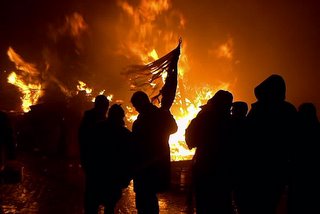 Hogmanay - Wikipedia, the free encyclopedia
Hogmanay - Wikipedia, the free encyclopediaHogmanay is the Scots word for the celebration of the New Year in the Scottish manner. Its official date is the 31 December. However this is normally only the start of a celebration which lasts through the night until the morning of the 1 January or, in many cases, 2 January.
There are many customs, both national and local, associated with Hogmanay. The most widespread national custom is the practice of first-footing which starts immediately after midnight. This involves being the first person to cross the threshold of a friend or neighbor and often involves the giving of symbolic gifts such as coal, shortbread or silverware intended to bring different kinds of luck to the householder. This may go on throughout the early hours of the morning and well into the next day. The first-foot is supposed to set the luck for the rest of the year, so it is important that a suitable person does the job. A tall, dark man bearing a gift is preferred.
 An example of a local Hogmanay custom is the fireball swinging which takes place in Stonehaven, Kincardineshire in north-east Scotland. This involves local people making up balls of chicken wire, tar, paper and other flammable material to a diameter of about a metre. Each ball has 2 m of wire, chain or non-flammable rope attached. The balls are then each assigned to a swinger who swings the ball round and round their head and body by the rope while walking through the streets of Stonehaven from the harbor to the Sheriff court and back. At the end of the ceremony any fireballs which are still burning are cast into the harbor. Many people enjoy this display which is more impressive in the dark than it would be during the day. As a result large crowds flock to the town to see it.
An example of a local Hogmanay custom is the fireball swinging which takes place in Stonehaven, Kincardineshire in north-east Scotland. This involves local people making up balls of chicken wire, tar, paper and other flammable material to a diameter of about a metre. Each ball has 2 m of wire, chain or non-flammable rope attached. The balls are then each assigned to a swinger who swings the ball round and round their head and body by the rope while walking through the streets of Stonehaven from the harbor to the Sheriff court and back. At the end of the ceremony any fireballs which are still burning are cast into the harbor. Many people enjoy this display which is more impressive in the dark than it would be during the day. As a result large crowds flock to the town to see it.Scots Mark New Year With Fiery Ancient Rites

Biggar Bonfire







No comments:
Post a Comment